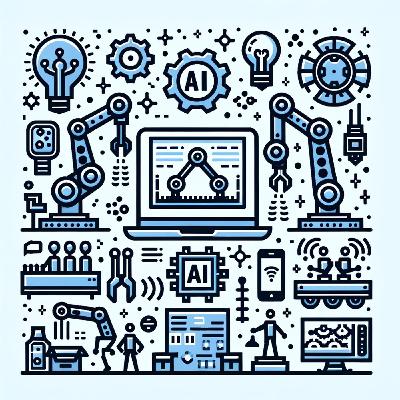Robots Steal Jobs, Slash Costs & Spy on You with AI!
Update: 2025-10-04
Description
This is you Industrial Robotics Weekly: Manufacturing & AI Updates podcast.
The world of industrial robotics is buzzing as manufacturers carry forward the automation renaissance powered by artificial intelligence, smart sensors, and advanced connectivity. As of 2025, the global market value of industrial robot installations has reached an all-time high of about sixteen and a half billion dollars, underscoring how technology innovation is reshaping the sector. Companies large and small are deploying robots and cobots to automate routine tasks, streamline their operations, and improve safety through intelligent collaboration. Recent news includes new multimodal robots rolling out in warehouse automation, designed for seamless integration with existing logistics software. These systems can autonomously manage picking, packing, and material transfer, improving productivity and offering thirty to forty percent greater throughput than manual processes. Another major development finds artificial intelligence taking a lead role in predictive maintenance and computer vision defect detection. For example, manufacturers using data-driven AI algorithms are anticipating equipment failures before they occur, slashing unplanned downtime by up to twenty percent while maintaining stringent quality control even as product demand fluctuates.
In a striking cost-analysis case, a European automotive plant reported a positive return on investment inside eighteen months after retrofitting legacy assembly lines with collaborative robots. Not only did the deployment halve material handling errors, but it also cut operational costs and improved overall equipment effectiveness thanks to real-time machine learning optimization. Technical standards, such as the latest ISO guidelines for robotic safety and interoperability, are now widely followed, ensuring scalability and cross-platform compatibility. These advances help teams onboard new systems without lengthy retraining, further reducing transition costs.
Manufacturing and process optimization now increasingly hinge on interconnected industrial internet of things devices. Digital twins, virtual replicas that simulate and monitor entire production facilities in real-time, allow plants to test new layouts, monitor machine health, and tweak processes for maximum efficiency—all before a single physical change is made. This analytical leap already yields actionable insights, allowing routine small-batch customization while maintaining mass-production scale. Warehouses, for their part, benefit from robots that safely work alongside people, reducing injuries and enhancing operational flexibility.
For those looking to stay ahead, now is the time to audit legacy systems for automation readiness, upskill workforces for human-robot collaboration, and plan for data-driven process upgrades. Secure your supply chain continuity by integrating smart sensors and AI analytics, which will be crucial as global economic and regulatory pressures rise. Looking forward, expect AI-powered robotics to drive new levels of adaptability, helping manufacturers withstand market volatility, unlock green manufacturing practices, and personalize products more rapidly than ever before. Thanks for tuning in. Be sure to come back next week for more Industrial Robotics Weekly. This has been a Quiet Please production and for more, check out Quiet Please Dot A I.
For more http://www.quietplease.ai
Get the best deals https://amzn.to/3ODvOta
This content was created in partnership and with the help of Artificial Intelligence AI
The world of industrial robotics is buzzing as manufacturers carry forward the automation renaissance powered by artificial intelligence, smart sensors, and advanced connectivity. As of 2025, the global market value of industrial robot installations has reached an all-time high of about sixteen and a half billion dollars, underscoring how technology innovation is reshaping the sector. Companies large and small are deploying robots and cobots to automate routine tasks, streamline their operations, and improve safety through intelligent collaboration. Recent news includes new multimodal robots rolling out in warehouse automation, designed for seamless integration with existing logistics software. These systems can autonomously manage picking, packing, and material transfer, improving productivity and offering thirty to forty percent greater throughput than manual processes. Another major development finds artificial intelligence taking a lead role in predictive maintenance and computer vision defect detection. For example, manufacturers using data-driven AI algorithms are anticipating equipment failures before they occur, slashing unplanned downtime by up to twenty percent while maintaining stringent quality control even as product demand fluctuates.
In a striking cost-analysis case, a European automotive plant reported a positive return on investment inside eighteen months after retrofitting legacy assembly lines with collaborative robots. Not only did the deployment halve material handling errors, but it also cut operational costs and improved overall equipment effectiveness thanks to real-time machine learning optimization. Technical standards, such as the latest ISO guidelines for robotic safety and interoperability, are now widely followed, ensuring scalability and cross-platform compatibility. These advances help teams onboard new systems without lengthy retraining, further reducing transition costs.
Manufacturing and process optimization now increasingly hinge on interconnected industrial internet of things devices. Digital twins, virtual replicas that simulate and monitor entire production facilities in real-time, allow plants to test new layouts, monitor machine health, and tweak processes for maximum efficiency—all before a single physical change is made. This analytical leap already yields actionable insights, allowing routine small-batch customization while maintaining mass-production scale. Warehouses, for their part, benefit from robots that safely work alongside people, reducing injuries and enhancing operational flexibility.
For those looking to stay ahead, now is the time to audit legacy systems for automation readiness, upskill workforces for human-robot collaboration, and plan for data-driven process upgrades. Secure your supply chain continuity by integrating smart sensors and AI analytics, which will be crucial as global economic and regulatory pressures rise. Looking forward, expect AI-powered robotics to drive new levels of adaptability, helping manufacturers withstand market volatility, unlock green manufacturing practices, and personalize products more rapidly than ever before. Thanks for tuning in. Be sure to come back next week for more Industrial Robotics Weekly. This has been a Quiet Please production and for more, check out Quiet Please Dot A I.
For more http://www.quietplease.ai
Get the best deals https://amzn.to/3ODvOta
This content was created in partnership and with the help of Artificial Intelligence AI
Comments
In Channel





